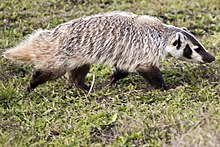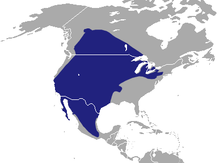American badger
| American badger | |
|---|---|
 |
|
| In Point Reyes National Seashore, California | |
| Scientific classification | |
| Kingdom: | Animalia |
| Phylum: | Chordata |
| Class: | Mammalia |
| Order: | Carnivora |
| Family: | Mustelidae |
| Subfamily: | Taxideinae |
| Genus: |
Taxidea Waterhouse, 1839 |
| Species: | T. taxus |
| Binomial name | |
|
Taxidea taxus (Schreber, 1778) |
|
 |
|
| American badger range | |
The American badger (Taxidea taxus) is a North American badger, somewhat similar in appearance to the European badger. It is found in the western and central United States, northern Mexico, and south-central Canada to certain areas of southwestern British Columbia.
American badger is a habitat is typefied by an open grasslands with available prey (such as mice, squirrels, and groundhogs). The species prefers areas such as prairie regions with sandy loam soils where it can dig more easily for its prey.
The American badger is a member of the Mustelidae, a diverse family of carnivorous mammals that also includes the weasel, otter, ferret, and wolverine. The American badger belongs to the Taxidiinae, one of three subfamilies of badgers – the other two being the Melinae (9 species, including the Eurasian badger) and the Mellivorinae (honey badger). The American badger's closest relative is the prehistoric Chamitataxus.
Recognized subspecies include: the nominate subspecies T. t. taxus, found in central Canada and central US; T. t. jacksoni, found in the southern Great Lakes region including southern Ontario; T. t. jeffersoni, in British Columbia and the western US; and T. t. berlandieri, in the southwestern US and northern Mexico. Ranges of subspecies overlap considerably, with intermediate forms occurring in the areas of overlap.
In Mexico, this animal is sometimes called tlalcoyote. The Spanish word for badger is tejón, but in Mexico this word is also used to describe the coati. This can lead to confusion, as both coatis and badgers are found in Mexico.
The American badger has most of the general characteristics common to badgers; with stocky and low-slung bodies with short, powerful legs, they are identifiable by their huge foreclaws (measuring up to 5 cm in length) and distinctive head markings. Measuring generally between 60 and 75 cm (23.5 and 29.5 in) in length, males of the species are slightly larger than females (with an average weight of roughly 7 kg (15 lb) for females and up to almost 9 kg (20 lb) for males). Northern subspecies such as T. t. jeffersonii are heavier than the southern subspecies. In the fall, when food is plentiful, adult male badgers can exceed 11.5 kg (25 lb).
...
Wikipedia

